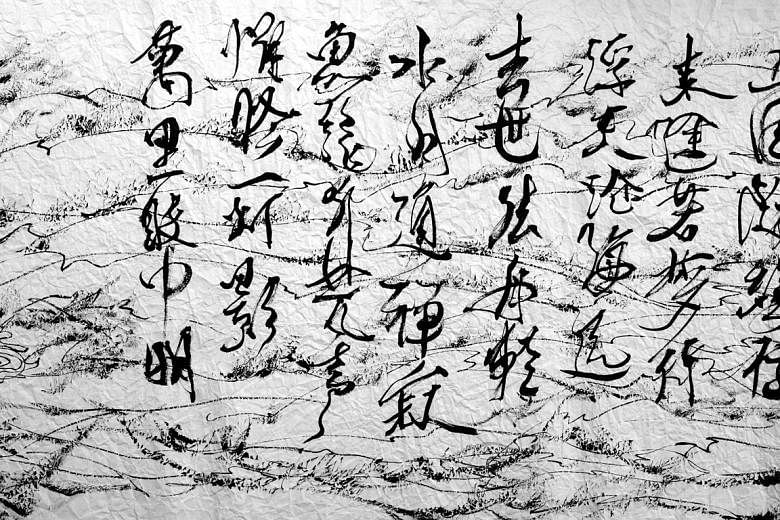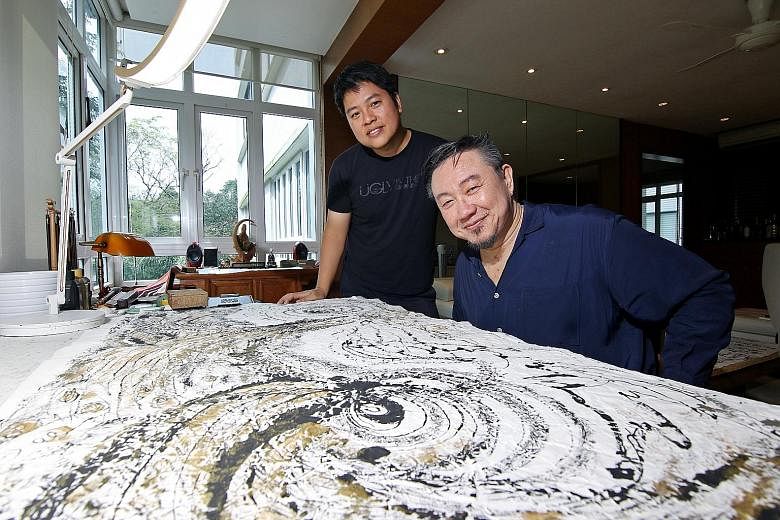Mark Chan is perhaps better known for his work as a singer-songwriter, composer and musical director of theatre productions and arts festivals.
But now, he wants to make his mark as a painter - starting with a showcase of about 50 new works that will be on display at the Esplanade from Jan 18 to the end of March.
Ink Mountain will feature paintings and calligraphy from the past two years, as well as video projections by multimedia artist Brian Gothong Tan.
The show at the Jendela arts space is commissioned by the Esplanade and is held in conjunction with the Singapore bicentennial commemoration this year.
"I'd like this to be a declaration of me stepping onto the art stage as a painter," says Chan.
The 60-year-old's last exhibition was in 1991, when the late dramatist Kuo Pao Kun invited him to show his paintings at The Substation as part of a series of concerts.
In his paintings, as in much of his music, there is a blend of East and West. While most of his vivid, abstract paintings are black Chinese ink on distressed paper - occasionally with flashes of gold and silver - there are also elements that might remind the viewer of works by famous Western painters such as Jackson Pollock, a major figure in the abstract expressionist movement; and Vincent Van Gogh, commonly associated with the post-Impressionist period.
In Chan's works, which also draw on South-east Asian influences, one can make out birds, concentric circles, volcanos and ships. The sea is a recurring theme and nature figures more prominently than mankind.
-
VIEW IT / INK MOUNTAIN
-
WHERE: Jendela (Visual Arts Space), Level 2, Esplanade - Theatres on the Bay, 1 Esplanade Drive
WHEN: Jan 18 to March 31, 11am to 8.30pm (Mondays to Fridays); 10am to 8.30pm (weekends).
There will be a talk, meet-the-artists session, guided walk through the exhibition and a book launch of Ink Mountain - images of selected works from the show, with poetry and writings by Mark Chan - on Jan 26, at 3pm
ADMISSION: Free
INFO: Go to www.facebook.com/markchanartist or call the Esplanade at 6828-8377
"There's a lot of sea... garnets plunging into the sea, a volcano next to the sea... When you go anywhere in South-east Asia, the sea is never that far away."
There are also some pieces of Chinese calligraphy featuring Chan's poems, as well as several by Tang poets, such as Qian Qi's Seeing A Monk Off To Japan - a poem about a Japanese monk who travelled to Chang'an to study the sutras, and is now returning to Kyoto.
Chan, who is a self-taught calligrapher and painter in Chinese ink, says his interest in the visual arts began at an early age: When he was a child, he was selected to represent Singapore at the Unicef Child Art Festival, held in conjunction with the Mexico Olympics in 1968.
But he would turn to Chinese brush, ink and paper only in his 20s, when he was due to go to Taipei to meet singers and producers. Unable to read, write or speak much Mandarin, he started attending night classes.
Later, he decided that the best way to learn would be to write out the characters with brush and ink on traditional paper. He fell in love with the medium, and found that the act of using a brush to write out the characters - which could not be covered over - was akin to the act of performing music live.
Painting had always taken a back seat to his music until recently.
In 2015, he returned to Singapore after 14 years of being based abroad.
This was a difficult time: a long-term relationship had ended, and an accident had damaged his left hand and wrist, leaving him unable to play the flute and guitar with the same proficiency as before.
"I took painting up not (just) as an art, but as a daily practice and meditation... I wanted to use it to work through a lot of pain, breakage and loss," adds Chan, who burns incense before he works, and paints while listening to music ranging from Ravel to Ed Sheeran.
Ink Mountain, he says, is "a very personal exhibition. I've really opened up my heart".
"I want people to enter my world, which is fantastical, yet a heightened reflection of the world as it is."
Music still plays a part in his life. He released a solo album Blue Guitar in 2016, and recently composed the score for the Indian film Painting Life (2018).
The former national swimmer, who admits that he is "interested in everything", has also been working on his debut novel - a work of speculative fiction set in Seville, Shanghai and Singapore.
The works on display at Ink Mountain are all for sale, and will probably cost between $2,000 and $9,000 each, Chan says.
Tan, 38, first worked with Chan when he did video work for Chan's contemporary dance production Dreaming Of Kuanyin, Meeting Madonna, presented at the Singapore Arts Festival in 2007.
For Ink Mountain, Tan is conceptualising a number of video projections, which are his interpretations of the paintings.
These include animations where the lines of the paintings are set in a swirling motion.
"When I saw (Mark's work), I could relate to it quite strongly. I felt it was very fresh... I could see landscapes, but it was more mindscapes than classical Chinese mountains," says Tan.
"My gut instinct was to animate it - there is so much animation in his work already. I wanted to make it come alive."



